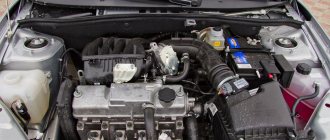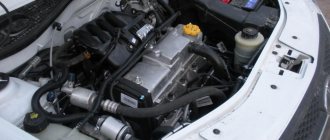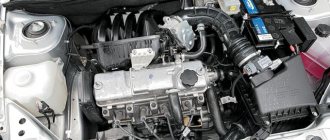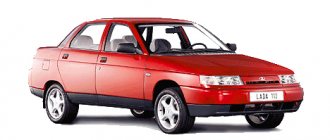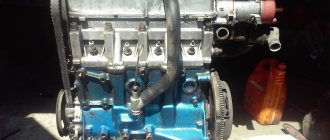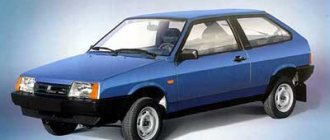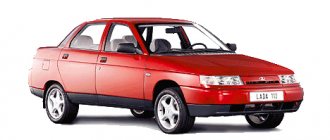Download .xls file
xls
Download picture
Send by email
| PARAMETER | MEANING |
| Number of cylinders | 4 |
| Volume, l | 1.596 |
| Piston stroke, mm | 75.6 |
| Compression ratio | 11 |
| Number of valves per cylinder | 4 |
| Cylinder block material | Ductile iron |
| Supply system | injector |
| Gas distribution system | DOHC |
| Cylinder operating order | 1-3-4-2 |
| Rated motor power | 78 kW (106.0 hp)/ 5800 rpm |
| Maximum torque | 148 Nm / 4000 rpm |
| Supply system | Electronically controlled distributed injection |
| Min octane number of gasoline used | 95 |
| Recommended Engine Oil | Synthetic |
| 5W-30 | |
| 5W-40 | |
| 10W-30 | |
| 10W-40 | |
| 15W-40 | |
| Oil volume in the lubrication system | 3.5 l |
| Oil quantity when changing | 3-3.2 l |
| Engine weight included, kg | 116 |
| Oil change carried out, km | 10000 |
The motor is installed on LADA Priora, Lada Kalina 2 and Lada Granta.
Description
The new VAZ 21127 engine is based on the VAZ-21126 gasoline engine, the main engine of the Priora, and is practically no different from it.
At the same time, the new Priora engine has some features:
- The engine is equipped with an intake control system, due to which it was possible to increase its power from 98 to 106 horsepower. With a 106 hp engine, according to owners' reviews, overtaking has become calmer.
- At the same time, the torque increased slightly to 148 Nm. The increase at average speed of the 127 engine was 10 Nm, which affected the dynamic characteristics of the engine.
- The engine control controller has received new calibrations, and instead of a mass air flow sensor, a DBP (absolute pressure sensor) is used. As a result of the modification, the VAZ 21127 engine received more improved parts.
Body dimensions and weight of the Lada Priora car - hatchback, station wagon, sedan, coupe, long
The ideal car is different for everyone - it all depends on why they are buying it. Priora is perfect for both the younger generation and the older. The weight that it can lift varies - for example, the station wagon received a voluminous trunk that can accommodate more things. The width of the Priora remains unchanged - exactly 164 cm. The weight of the car ranges from 1578 to 1598 kg.
Hatchback
When it comes to overall dimensions, the Lada Priora cannot but rejoice - you can drive with it even in the narrowest yard. The curb weight of the hatchback is 1163 kg, the maximum permissible is 1578 kg. The trunk volume is 360 liters, and with the seats folded down – 705 liters. Height is 143.5 cm, length – 421 cm.
Sedan
The dimensions of the sedan are slightly different, but the weight of the car remains the same. The trunk volume is 430 liters. The sedan body dimensions are 142 cm in height, length is 435 cm.
Station wagon
The improved technical characteristics of the Lada Priora station wagon allow you to seriously load the trunk - they took care of the reinforced suspension in advance. Unlike the hatchback, the station wagon has a length of 13 cm longer - 434 cm. The height is 150.8 cm. The trunk volume is 444 liters and 777 liters with the seats folded down. The total weight can be equal to 1598 kg.
Coupe
The three-door hatchback Lada Priora was produced in a sports version and featured improved characteristics - after restyling, there were 123 horses under its hood. The body elements had to be redone, which did not affect the dimensions so much. Length is 424.3 cm, height 143.5 cm.
Long body
The extended Priora is the Premier version, premium. Its base was lengthened by 17.5 cm, the rear door was made larger, and an additional section was added to the glass. Under the hood there is a noticeable advantage - more “horses” are needed to pull a heavier car. The salon is decorated elegantly and stylishly. The width remains the same - 168 cm, the length is 452.5 cm, and the height is 142 cm. The curb weight is 1100 kg, and the trunk volume remains the same - 430 liters.
Design
- The four-stroke 127 engine of the Lada Priora has an in-line cylinder arrangement and a distributed injection system; The camshaft is located at the top of the engine.
- Closed cooling system with forced coolant circulation.
- A combined type lubrication system is supplied to the rubbing surfaces using pressure and oil spraying.
- The high-strength cast iron cylinder block is made by casting, and the walls are processed in accordance with Federal Mogul technology. Cylinder counting begins from the crankshaft drive pulley side.
How to increase clearance yourself
You can increase the clearance yourself. Most often, special devices are used for this - spacers.
Selection of materials
Spacers to increase vehicle clearance are made from the following materials:
Each material has its own advantages and disadvantages.
Rubber spacers
- resistant to external influences in the form of acid, salt, alkali;
- do not affect vehicle handling and comfort in the cabin;
- do not have a corrosive effect on the car body;
- They are inexpensive on the car market.
- rapid wear;
- subject to deformation and damage.
Rubber spacers are secured under the springs.
Polyurethane spacers
In addition to the advantages of rubber, they have in addition:
- higher strength;
- can take a significant load without breaking;
- capable of smoothing out impacts from uneven road surfaces.
The disadvantages include:
- high pressure on the bushings;
- possibility of deformation of the car body.
These spacers are also suitable for installation under springs. They cost more than rubber ones, but cheaper than metal ones.
Aluminum spacers
All of the above advantages of other materials are more pronounced in aluminum spacers. In addition, they do not wear out for a long time.
The only significant drawback is the possibility of corrosive effects upon contact with the car body. They are usually attached at the junction of the shock absorbers with the car.
ABS plastic
Currently, it is the most acceptable material for spacers in the automotive market. It has all the advantages of previous models, but without their disadvantages.
Plastic spacers are placed under the springs.
Installing spacers on the front of the car
Installation of spacers at the front of the machine is carried out according to the following instructions:
- The car is jacked up and the wheel is removed.
- Disconnect the brake hoses and unscrew a couple of nuts from the front strut, having previously tightened the springs with a tie.
- The stand is removed by unscrewing the nuts from the upper support.
- Old bolts are replaced with new ones of longer length.
- The spacer is bolted and assembled in the reverse order. If there is interference from the transverse pillar, it is supported with a second jack.
- All the same actions are repeated with the second wheel.
Installing rear spacers
Installation of spacers on the rear of the car is carried out according to the following instructions:
- The thresholds from the rear doors of the car and under the luggage compartment lid are removed.
- The rear seats move forward as much as possible. Remove the trim from the trunk and sides, completely exposing the body.
- Raise the car from behind with a jack and remove the wheel.
- Tighten the nuts from above and below, remove the support.
- Old bolts are replaced with new ones of longer length.
- Attach the spacer to the bolts and reassemble in the reverse order.
- metal spacers must undergo anti-corrosion treatment;
- if a passenger car has front-wheel drive, it should not be raised higher than 20 mm;
- in 80% of cases it is advisable to install spacers both above and below the spring for synchronization;
- when installing spacers at the rear, you need to take into account the angle of the car (it is better not to raise it by more than 30 mm);
- if you increase the clearance by more than 30 mm, there may be problems with cambering the car;
- The spacers must be supplied with bolts and studs of appropriate size.
Service
The power unit must undergo periodic maintenance every 10 thousand kilometers. Under severe operating conditions, oil and filter changes should be carried out every 7.5 thousand.
When replacing the oil filter, you should pay attention to oil leakage through the valve cover seals. This malfunction is due to the poor quality of the sealing gasket, which leads to contamination of the cooling surfaces and overheating of the motor.
A special feature of the maintenance of this engine is the periodic replacement of hydraulic valve compensators.
When operating a car with this engine, its temperature should be controlled - 95-98 degrees Celsius, otherwise the elements of the cooling system will wear out very quickly. The cause of this is usually the thermostat, which is the weak element in this system.
Removal of the exhaust pipe should be carried out with extreme caution; instead of copper nuts, the manufacturer installed steel ones; if they sour, the mounting brackets can break off. When carrying out this type of work, it is better to immediately replace these nuts with copper ones.
The worst feature of this engine is that when it fails, the engine bends the timing valve, leading to expensive repairs. Tensioning and replacing the timing belt is best done at a service center. The Lada Priora engine has 106 hp. p., according to reviews from owners, high-quality oil should be poured, otherwise the hydraulic valve compensators will fail very quickly.
The engine is also marked by knocking in the elements of the crank mechanism, main and connecting rod bearings, while the engine shakes.
Advantages and disadvantages of the 126 motor
The automotive community treats the VAZ 21126 engine differently. Some consider it one of the coolest, others say that the engine failed due to numerous problems and weak points of the power unit.
The advantages of this internal combustion engine include:
- a new sixteen-valve BC head, with two shafts for distributing flammable gases and four valves for each cylinder;
- diluted system of intake and exhaust gases;
- more powerful motor with more torque compared to previous models
- injection power system with distributed, phased injection.
- installation of a catalytic exhaust gas converter.
- compliance with European environmental requirements for harmful, toxic exhaust emissions, Euro 3 and 4.
Flaws
The 126 model engine is rich not only in advantages, but also in disadvantages, such as:
- The most significant disadvantages include problems with the timing belt drive; as already mentioned, problems may appear before the service life declared by the manufacturer;
- and of course, an important drawback is the low quality of many components, sensors, parts and mechanisms, which was discussed in the previous chapter.
Malfunctions
Despite various upgrades, the engine in the VAZ 21127 retained all the faults of its predecessor, the main ones of which are shown in the table:
| FAULT | CAUSE |
| The engine starts to stall | Coking of injectors. |
| Malfunction of ignition coils. | |
| Reduced compression. | |
| Cooling system overheating | Thermostat malfunction. |
| Formation of a mud coat as a result of oil leakage. | |
| Knocks and noises at the top of the engine | Malfunctions of hydraulic valve compensators |
| Knocks at the bottom of the engine | Main bearing wear |
| Knocks in the middle of the engine | Connecting rod bearings and piston pin faults |
| Bend cylinder head valves | Belt drive slipping through gear tooth |
| Interruptions and startup problems | Violations in the operation of the timing belt. |
| Malfunctions in the fuel pressure system. | |
| Air leak. | |
| Broken throttle valve. | |
| Sensor malfunction. | |
| Power reduction | Burnt out timing head gasket. |
| Burnout of pistons, wear of rings and cylinders. |
Signs of the need for internal combustion engine repair
The reasons why the operation of the engine is disrupted are arranged in a small list, starting with refusal to start and ending with floating idle speed (this problem was removed on the 127 “engine”). Not all breakdowns end in capital damage - sometimes it’s enough to add oil, sometimes it’s enough to adjust the ECU settings.
Compression reduction
A decrease in cylinder compression below 16 atmospheres is a bad sign. Such a high limit corresponds to a compression ratio of 11.
If the compression decreases (or vice versa increases), then the “engine” will have to be rebuilt.
Knocks in the engine
Engine knocks can come from several points. These could be hydraulic compressors, timing belt rollers or pins. The knocking noise could also be caused by low oil level. The answer to the question will be given by a thorough detailed inspection of all parts of the unit and checking the oil level.
Blue smoke from the exhaust pipe
The blue smoke that comes from the exhaust pipe appears when oil enters the combustion chamber. It can leak either from the valves or from under the piston. The result is the same: the oil is eaten up and blue smoke pours out of the chimney. Once the leak is located, half the problem will already be solved.
Troit motor
Sometimes in the cold the engine may stall - don’t be alarmed by this, because it may simply be one of the spark plugs that fails. In this case, we advise you to simply restart the engine and it will stop running.
How much does it cost to overhaul a Priora engine - average price
Self-repair of a Priora engine with 16 valves costs an average of 16-20 thousand rubles. The cost depends on the severity of the breakdown and may be lower or higher than this average range. Repairing a Priora engine can be entrusted to the wrong hands, but then you will have to pay for the work - sometimes the cost of repairs reaches as much as 40 thousand rubles.
This is an unreasonably inflated figure, because, as practice shows, you can rebuild the engine on a Priora, working at a moderate pace, in just three days - and three days of work is definitely not worth that kind of money. Don’t be afraid of not being able to cope - your Lada is easy to repair, and using the advice and “tutorials”, you will conquer even such a task that is impossible at first glance.
Tuning
Due to the fact that the design of the engine has not fundamentally changed, tuning the Priora engine is carried out using the same methods as on the 126 engine. In a Priora car, engine tuning can be done in several ways:
- The easiest way to do chip tuning of a Priora engine is to flash the control unit. Chip tuning will not make any significant changes to the technical characteristics of the engine; the increase will only be about 5 liters. With.
- To slightly increase the dynamic performance, it is enough to simply change the exhaust with a pipe diameter of 51 m and a 4-2-1 spider and change the damper with a size of 54 mm. These changes will increase engine power by 10-15 horsepower and slightly increase the dynamics of the car.
- For more serious tuning, you will need to install Stolnikov 8.9 shafts with a phase of 280. This change will increase acceleration to hundreds in 9 seconds.
- The use of 9.15 shafts with a 316 phase will make it possible to significantly increase the dynamics when starting in urban conditions, but for this you will have to bore the channels for the 31 mm/27 mm valve and change the injectors to more efficient ones. Injectors from BOSCH 431 360cc and BOSCH 440cc are well suited for these purposes.
The use of such changes will increase engine power by 30-40 horses. If these measures are insufficient, then the receiver will need to be replaced, a compressor installed, or the engine turbocharged.
Increasing ground clearance using spacers: pros and cons
As it may seem at first glance, spacers for springs and spacers for struts have the same advantages. Simply put, you can quickly and cheaply increase ground clearance by preparing your car for bad roads, improve cross-country ability, increase load capacity, etc. In fact, this is true, but there are also disadvantages.
Currently reading:
How to make tire ink yourself: the best ways
Jun 28, 2020
VAZ 2110 windshield wiper trapezoid: do-it-yourself replacement
Jun 28, 2020
The fact is that installing spacers to increase ground clearance is fully justified only when there is a change in ground clearance as a result of sagging springs or the car often drives loaded off-road, and at low speed.
By the way, even in this case, you should not install spacers whose thickness is more than 3 cm, and always make allowances for the material they are made of. If the ground clearance is normal and the springs are in order, before installing spacers both front and rear, you should take into account a number of disadvantages of such a modification.
If we talk about the disadvantages of spacers, then:
- an increase in ground clearance leads to a shift in the car’s center of gravity, which impairs the stability and controllability of the car;
- the rigidity changes and the reliability of the suspension suffers, the wheel alignment angles and a number of other important parameters change;
- The steering wears out more, the operation of the shock absorbers changes, and their service life is reduced;
To put it simply, the suspension arms are constantly lowered, the geometry changes, and the operating conditions of the suspension parts change. As a result, the angle of inclination of the steering axis, track width, wheel alignment, etc. may change.
The operating conditions of the silent blocks also change, and the adjustment of the braking forces on the rear axle may change. As for shock absorbers, in the case when, to increase ground clearance, only spacers for the springs were installed, and without spacers for the shock absorber, the average position of the shock absorber piston changes.
As a result, the shock absorber works so that its piston rests against the top cover. Naturally, the service life of shock absorbers is reduced, and noticeably. Of course, all this has an even greater impact on the overall life of the suspension.
However, a much more serious problem is worse handling. In the case of active maneuvering, as well as in emergency situations, the car becomes much less stable. It turns out that if the car is actively used in normal modes, the driver is used to driving at high speeds, then a spacer to increase the ground clearance may not be the best and very unsafe solution.
It should also be noted that after increasing the ground clearance, some owners begin to overload the car with all sorts of cargo, since spring sag is no longer such an acute problem. However, we should not forget that in this case the load on the body, chassis parts, internal combustion engine, transmission, etc. increases significantly.
Add a comment Cancel reply
You must be logged in to post a comment.
From this article you will learn the dimensions of the Lada body and its features. Our domestic designers have finally managed to carry out high-quality body engineering that meets international standards. Finally, the torsional rigidity (TR) of the bodies of Lada Largus, Kalina, etc. and other features, to the envy of previous VAZ models, have become much higher. This means that now domestic models can easily compete with foreign cars in terms of body endurance.
Compressor for Priora
An alternative method of obtaining such power is to install a compressor, for example, the most popular option is an Auto Turbo kit based on PK-23-1, this compressor is easily installed on a 16-valve Priora engine, but with a lower compression ratio. Then there are 3 options: 1
.
The most popular is to lower the coolant gasket with a gasket from a twelve-wheeler, install this compressor, exhaust on 51 pipes, Bosch 107 injectors, install it and go to the track to watch the car go downhill. But the car doesn’t run very well... then running to sell the compressor, writing that the Autoturbo doesn’t work and all that... is not our option. 2
.
We lower the coolant by installing a thick cylinder head gasket from 2112, for a St. Petersburg supercharger at a pressure of 0.5 bar this will be enough, we select the optimal narrow-phase shafts (Nuzhdin 8.8 or similar), exhaust 51 pipes, Volga BOSCH 107 injectors, a receiver and a standard throttle body. To fully push the configuration, we give the cylinder head to cut the channels, install larger lightweight valves, this is not expensive and will provide additional power throughout the entire range. This whole thing needs to be configured online! We’ll get an excellent motor with a power of more than 150-160 hp that can perform in any (!) range. 3
. We lower the coolant by replacing the piston with a tuning one for the turbo, you can put a proven Nivov piston with a puddle under the turbo on 2110 connecting rods, on such a config you can put a more efficient compressor, a Mercedes one for example, blowing 1-1.5 bar with a power well over 200+ hp . and act like the devil!) The advantage of the config is the ability to install a turbine on it in the future and blow out at least all 300+ hp. if the piston doesn't go to hell))
